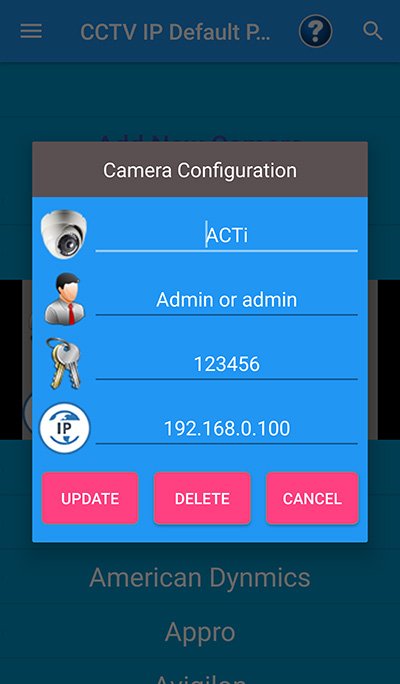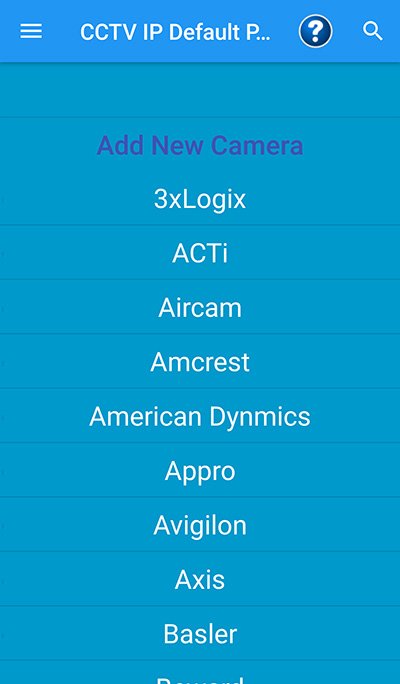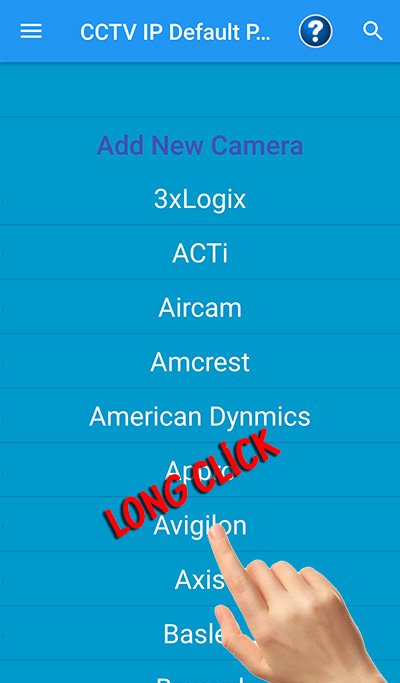The CCTV IP Default Password application allows you to find forgotten default passwords for Cameras.
The application only contains factory default passwords. The information of all the cameras is collected in this application. It contains information from different camera companies around the world.
It's easy to use. You can use for CCTV devices, CCTV camera, ip camera, DVR devices, NVR devices, XVR devices.
You can add your own camera, delete cameras or make changes to cameras if you want. Cameras are listed alphabetically.
Supported companies;
3xLogic, ACTi, Aircam, Amcrest, American Dynmics, Appro, Aprica, Arecont Vision, AvertX, Avigilon, Axis, Beward, Basler, BlueStork, Bosch, Brickcom, Canon, Cantek, CBC Ganz, Genoa, Cisco, CNB, Costar , CP Plus, Dahua, Digital Watchdog, DRS, Dunlop, DVTel, DynaColor, EasyN, FlexWatch, FLIR, Foscam, GeoVision, Grandstream, GVI, Haikon, Hanwha, HIKVision, Honeywell, IndigoVision, Instar, Intello, Interlogix, IPEYE , IOImage, IPXA H264, IPXA H265, IPX-DDK, IQInvision, JVC, Lilin, Longse, Lorex, LTS Security, March Networks, MATRIXtech, Merit Lilin Camera, Merit Lilin Recorder, Messoa, Microdigital, Mobotix, Northern, Novicam, Oncam , OpenEye, Panasonic, Pelco
PiXORD, Polyvision, OnVif, Q-See, QVIS, Reolink, Rivatech, Samsung, Sanyo, Scallop, Sentry360, Sony, Space Technology, Speco, StarDot, Starvedia, Sunell, SV3C, Swann, Tiandy, Toshiba , Trendnet, Telexper, TrueVision, UDP, Ubiquiti, Uniview, Verint, Videocomm, VideoIQ, Vivotek, W-Box, Wodsee, Zavio.
Specifications;
- Adding new camera information
- Change camera info
- Delete camera information
- Sorted camera list
- Detailed application introduction
- Searching from the camera list
https://www.facebook.com/ilkerdanali/
http://www.ilkerdanali.com
Introduction
Closed-circuit television (CCTV) systems play a crucial role in surveillance and security applications. However, default passwords used in CCTV IP cameras can pose significant security risks if not changed promptly. This guide provides a detailed overview of CCTV IP default passwords, their implications, and best practices for enhancing network security.
Default Passwords and Their Implications
Many CCTV IP cameras come with default passwords that are often simple and easily guessable. These passwords are typically set by the manufacturer for initial setup and testing purposes. However, if not modified, they can be exploited by unauthorized users to gain access to the camera's live feed, record footage, or even manipulate the camera's settings.
Identifying Default Passwords
Default passwords for CCTV IP cameras can vary depending on the manufacturer and model. However, some common default passwords include:
* "admin"
* "12345"
* "password"
* "guest"
Consequences of Unchanged Default Passwords
Leaving default passwords unchanged can have severe consequences for network security, including:
* Unauthorized Access: Hackers can exploit default passwords to access the camera's live feed, allowing them to monitor activities, steal sensitive information, or commit cybercrimes.
* Camera Manipulation: Attackers can modify camera settings to disrupt surveillance, disable recording, or redirect the camera's view to private areas.
* Network Breaches: CCTV IP cameras are often connected to networks, providing a potential entry point for attackers to gain access to other network devices and systems.
Best Practices for Enhancing Security
To mitigate the risks associated with default passwords, it is essential to implement the following best practices:
* Change Default Passwords: Immediately change the default password to a strong, unique password that is not easily guessable.
* Use Complex Passwords: Passwords should be at least 12 characters long and include a combination of uppercase, lowercase, numbers, and symbols.
* Disable Default Accounts: If possible, disable any default user accounts that are not necessary.
* Enable Two-Factor Authentication: Implement two-factor authentication to add an extra layer of security, requiring users to provide a second form of verification (e.g., a code sent to their phone).
* Regularly Update Firmware: Keep the camera's firmware up to date to address any security vulnerabilities that may arise.
Conclusion
Default passwords in CCTV IP cameras pose significant security risks that can compromise network security. By implementing best practices for changing default passwords, using complex passwords, disabling unnecessary accounts, enabling two-factor authentication, and regularly updating firmware, organizations can protect their CCTV systems and maintain a secure network environment.
The CCTV IP Default Password application allows you to find forgotten default passwords for Cameras.
The application only contains factory default passwords. The information of all the cameras is collected in this application. It contains information from different camera companies around the world.
It's easy to use. You can use for CCTV devices, CCTV camera, ip camera, DVR devices, NVR devices, XVR devices.
You can add your own camera, delete cameras or make changes to cameras if you want. Cameras are listed alphabetically.
Supported companies;
3xLogic, ACTi, Aircam, Amcrest, American Dynmics, Appro, Aprica, Arecont Vision, AvertX, Avigilon, Axis, Beward, Basler, BlueStork, Bosch, Brickcom, Canon, Cantek, CBC Ganz, Genoa, Cisco, CNB, Costar , CP Plus, Dahua, Digital Watchdog, DRS, Dunlop, DVTel, DynaColor, EasyN, FlexWatch, FLIR, Foscam, GeoVision, Grandstream, GVI, Haikon, Hanwha, HIKVision, Honeywell, IndigoVision, Instar, Intello, Interlogix, IPEYE , IOImage, IPXA H264, IPXA H265, IPX-DDK, IQInvision, JVC, Lilin, Longse, Lorex, LTS Security, March Networks, MATRIXtech, Merit Lilin Camera, Merit Lilin Recorder, Messoa, Microdigital, Mobotix, Northern, Novicam, Oncam , OpenEye, Panasonic, Pelco
PiXORD, Polyvision, OnVif, Q-See, QVIS, Reolink, Rivatech, Samsung, Sanyo, Scallop, Sentry360, Sony, Space Technology, Speco, StarDot, Starvedia, Sunell, SV3C, Swann, Tiandy, Toshiba , Trendnet, Telexper, TrueVision, UDP, Ubiquiti, Uniview, Verint, Videocomm, VideoIQ, Vivotek, W-Box, Wodsee, Zavio.
Specifications;
- Adding new camera information
- Change camera info
- Delete camera information
- Sorted camera list
- Detailed application introduction
- Searching from the camera list
https://www.facebook.com/ilkerdanali/
http://www.ilkerdanali.com
Introduction
Closed-circuit television (CCTV) systems play a crucial role in surveillance and security applications. However, default passwords used in CCTV IP cameras can pose significant security risks if not changed promptly. This guide provides a detailed overview of CCTV IP default passwords, their implications, and best practices for enhancing network security.
Default Passwords and Their Implications
Many CCTV IP cameras come with default passwords that are often simple and easily guessable. These passwords are typically set by the manufacturer for initial setup and testing purposes. However, if not modified, they can be exploited by unauthorized users to gain access to the camera's live feed, record footage, or even manipulate the camera's settings.
Identifying Default Passwords
Default passwords for CCTV IP cameras can vary depending on the manufacturer and model. However, some common default passwords include:
* "admin"
* "12345"
* "password"
* "guest"
Consequences of Unchanged Default Passwords
Leaving default passwords unchanged can have severe consequences for network security, including:
* Unauthorized Access: Hackers can exploit default passwords to access the camera's live feed, allowing them to monitor activities, steal sensitive information, or commit cybercrimes.
* Camera Manipulation: Attackers can modify camera settings to disrupt surveillance, disable recording, or redirect the camera's view to private areas.
* Network Breaches: CCTV IP cameras are often connected to networks, providing a potential entry point for attackers to gain access to other network devices and systems.
Best Practices for Enhancing Security
To mitigate the risks associated with default passwords, it is essential to implement the following best practices:
* Change Default Passwords: Immediately change the default password to a strong, unique password that is not easily guessable.
* Use Complex Passwords: Passwords should be at least 12 characters long and include a combination of uppercase, lowercase, numbers, and symbols.
* Disable Default Accounts: If possible, disable any default user accounts that are not necessary.
* Enable Two-Factor Authentication: Implement two-factor authentication to add an extra layer of security, requiring users to provide a second form of verification (e.g., a code sent to their phone).
* Regularly Update Firmware: Keep the camera's firmware up to date to address any security vulnerabilities that may arise.
Conclusion
Default passwords in CCTV IP cameras pose significant security risks that can compromise network security. By implementing best practices for changing default passwords, using complex passwords, disabling unnecessary accounts, enabling two-factor authentication, and regularly updating firmware, organizations can protect their CCTV systems and maintain a secure network environment.












